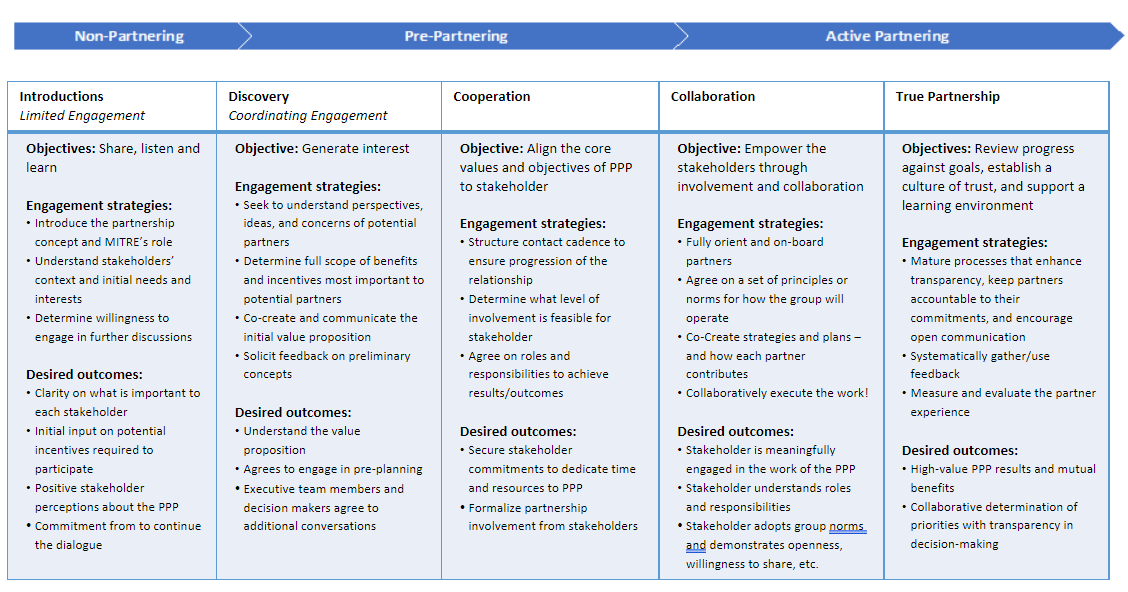Trust: The Essence of Collaboration
Audience: General | Level: Foundational
Summary
This tool answers the following questions about trust:
- What do we mean by trust in the context of PPPs?
- What are general promising practices for building trust in PPPs?
- What are strategies and indicators of trust at each stage of a relationship?
- What enables sensitive data sharing?
- What are additional resources related to trust?

“Partnerships move at the speed of trust”
Building trust incrementally through small efforts within the partnership creates a record of small successes that support bigger strides. In other words, success breeds confidence, and confidence breeds trust.
What do we mean by trust in the context of PPPs?
Trust is a core value critical to the health and success of a PPP from the beginning and throughout the PPP lifecycle. To start, PPPs often require a leap of faith to try a new, innovative way to solve a problem. To endure, PPPs require a foundation of trust in each partner’s commitment, believing that each party will follow through in good faith according to their agreements. Because change is likely and reinvention becomes necessary, trust underlies PPPs’ ability to adapt over time.
Given the complex stakeholder ecosystems in which PPPs operate, trust is required among the multiple actors and entities to enable shared decision making and co-resourcing. Layers of trust include:
- Trust between private sector and public sector partners (e.g., in some cases industry partners may have distrust with government partners due to their regulatory or enforcement role within the industry)
- Trust among partners (e.g., in some cases partners are competitors in the market)
- Trust between the PPP Operator/Convener and partners (especially in circumstances where the Operator is a Trusted Third Party involving the sharing of sensitive data without an established reputation in the industry)
Trust is complex in any PPP, and each of the layers above are worthy of their own unique set of promising practices. In general, however, suffice it to say that trust is earned over time and reinforced through the strength of personal relationships, the details of legally-binding agreements between parties, and especially by keeping promises and collectively demonstrating concrete results.
What are general practices for building trust in PPPs?
- Seek understanding before commitment. Actively listen. Make stakeholders feel heard. Take time to meaningfully respond to the substantive input and perspectives of stakeholders.
- When it makes sense, co-create concepts, strategies, and plans to cultivate a sense of ownership, transparency, and trust.
- Keep your promises and generate tangible results. When partners realize the differentiated value that the PPP provides to them, their trust in the PPP grows and they will become your biggest advocates.
- People learn by doing, so provide opportunities for experiential learning. When partners actively participate in tabletop exercises, proofs of concept, pilots, or other experiments, they are often able to see the value of a (potential) PPP in a new and more meaningful way. Successful tactics:
- Move quickly to a proof of concept or prototype to get people building trust by working together and seeing early results
- In meetings, use techniques that encourage active participation
- Engage participants, even virtually, by using video-based technology that puts people at the heart of the interaction (i.e., not PowerPoint slides)
- Respect partners’ time and make it easy for them to participate. Most people are already in information overload, which generates impatience with messages and activities that do not get to the point quickly and succinctly. Successful tactics:
- Minimize the burden on their time to the extent possible
- Minimize email – and keep them short and to the point
- Tightly facilitate calls
- Carefully plan meetings, with specific learning and action objectives
- Establish mechanisms to enable communication, transparency, and trust-building, such as:
- At the early stages of a relationship, use video-based communications – and conduct face-to-face (F2F) interactions, when feasible – to develop enough trust for open exchanges of ideas
- Establish an atmosphere of transparency and sharing by helping participants get to know one another
- Build and enforce collaboration ground rules
- Create vehicles that make it easy for participants to share openly and reflect honestly (e.g., template with “3 things going well and 3 things I need help with”)
- Create opportunities for relationship building, and encourage informal forms of communication among partners, to help build more open and trusting relationships. Successful tactic:
- Schedule an extra 15 minutes of time prior to video-based meetings for casual check-ins and conversations, and/or with structured icebreakers or get-to-know you exercises (these can be optional)
- Schedule in-person meetings to allow for an overnight stay and plan social time (e.g., sports games, crabfests at the harbor)
- Establish processes that emphasize transparency in the execution of roles and responsibilities so partners understand what commitments are being kept, the nature of the follow-through, and what value is being generated.
- Give partners a forum and voice for honestly raising problems and issues so they can be identified early and resolved in good faith working together. Open, regular, and 2-way communication is essential.
What are strategies and indicators of trust at each stage of a relationship?
The objectives and engagement strategies needed to build trust and commitment evolve along the partnership lifecycle. The following table summarizes the stages of PPP relationship-building and can be used to help guide a PPP’s engagement strategy. The framework goes through three main phases: Non-Partnering, Pre-Partnering, and Active Partnering. This framework helps a team to tailor its strategies based on where a stakeholder organization is in the partnership process. There is pre-work done to establish that a PPP is a reasonable option for stakeholders to collectively address complex challenges. This step supports overall engagement strategy and moving through the partnering phases.

What enables sensitive data sharing?
Often in PPPs, collaboration and data-sharing between government and industry is difficult to establish. Many PPPs bring together competitors and their regulator around the same table to collaborate. It is essential to ensure that trust is established so data is voluntarily shared and used only for systemic improvements, not for competitive advantage or regulatory action.
A moderated panel of government and industry partners and MITRE leaders discussed this topic at a Technical Exchange Meeting in May of 2021. The key themes that emerged from the discussion include:
- Take reasonable legal steps to protect data shared with the PPP from compelled disclosure (e.g., FOIA, subpoena)
- Clearly define acceptable data uses and related safeguards
- Establish de-identification / non-attribution requirements for data and results
Commonly, both government and industry desire that data shared with the PPP is legally protected from compelled disclosure, and the panelists echoed this sentiment. Whether it is automotive, aviation, or healthcare data, ensuring these protections is often a prerequisite to sharing data with the partnership. Negotiated legal agreements between the government and private sector companies define strict parameters for what data is shared with whom, whether ownership of the data is transferred, and what can be publicly shared. And in some cases, legislation exists that guarantees data voluntarily shared with the government is protected from public disclosure – for example, 14 CFR Part 193 for aviation.
Additionally, proper and ethical data use in the PPP is another issue that must be proactively addressed to enable data sharing. Without establishing clarity over who will have access to the data and how it will be used, PPPs run the risk of participants walking away. At the outset, partners may feel somewhat vulnerable and must trust that data they share will be protected and appropriately used. (This is why it is important to start small with proofs-of-concept or pilots.) Further, partners must trust that there is value to be gained by aggregating their data with those of the other practitioners in their PPP to reveal otherwise unknowable insights at the systemic level. The model that has proven to be successful across multiple industries is one that leverages an independent and unbiased Trusted Third Party organization to serve as the data steward and analyst for the PPP. Using this model:
- Industry participants are unable to access sensitive data from their competitors
- Government participants are unable to access sensitive data from industry to use for enforcement
- All participants gain the benefit of access to results that they would not have known about by any other means
A third element to establishing trust is clearly defining de-identification / non-attribution requirements for both data going into the PPP and analysis results coming out. Panelists shared that ensuring anonymization of the data and results was critical to establishing trust. It is not important who the driver of the automobile was, or who the pilot of the aircraft was; instead, what matters is that many drivers or many pilots made the same mistake repeatedly, indicating a systemic risk.
What are additional resources related to trust?
Downloads
- Turf, Trust, Co-creation and Collective Impact

- SCARF: A Brain-based Model for Collaborating with and Influencing Others [SCARF = Status, Certainty, Autonomy, Relatedness, and Fairness]

- Building Trust with All Stakeholders Is Vital for Success : Implementing a Public-Private Partnership in the Electricity Sector in Guinea (Article)

- What makes public-private partnerships work? Survey research into the outcomes and the quality of cooperation in PPPs

